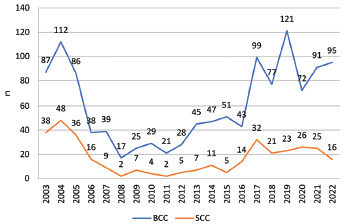Epidemiological data and clinico-pathological features of squamous and basal cell carcinoma: A 20-year single-institution experience
DOI:
https://doi.org/10.17532/jhsci.2023.2081Keywords:
Basal cell carcinoma, squamous cell carcinoma, non-melanoma skin cancerAbstract
Introduction: Basal cell carcinoma (BCC) and squamous cell carcinoma (SCC) are the most common skin malignancies in the heterogeneous group of non-melanoma skin cancer (NMSC). Due to increasing incidence these tumours remain significant health problem worldwide.
Methods: We conducted retrospective analysis to evaluate the incidence of primary BCCs and SCCs in our institution from 2003 to 2022, and to correlate it with available clinical data.
Results: We noticed that the incidence of NMSC increased between 2018 and 2022 (p<0.01). Among 1570 patients diagnosed with NMSC, BCC represented 77.9% of cases. BCC was constantly more common type of NMSC with statistically significant difference in the period from 2003-2005 and in the period from 2017- 2022 (p<0.01). Nodular subtype of the BCC was the most common, affecting primarily face. Superficial BCC occurred most commonly on trunk (p<0.01), affecting younger patients than the other histological subtypes (mean age 61.29±13.47 years (p<0.01). High-risk BCCs in men were more common on face and scalp (p<0.05). BCCs were predominantly smaller tumours (<2 cm) in contrast to SCCs with highest incidence in pT2-pT4 group (p<0.01). SCC patients were older (mean age 72.89±9.7) than BCC patients (mean age 65.15±12.80) (p<0.01).
Conclusion: In order to improve prevention strategies and prevent further increase in incidence, there is need to develop current and exact registries of these malignancies, especially separately BCC and SCC.
Downloads

Downloads
Published
License
Copyright (c) 2023 Nina Čamdžić, Suada Kuskunović-Vlahovljak, Mirsad Dorić, Mirsad Babić, Edina Lazović Salčin, Haris Čampara, Asja Prohić

This work is licensed under a Creative Commons Attribution 4.0 International License.










